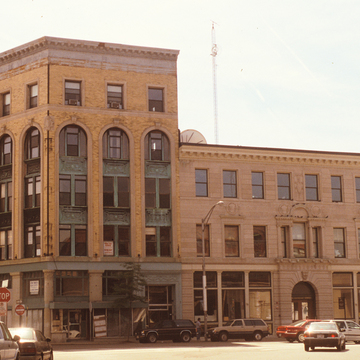South of the 1913 Boston & Maine Railroad viaduct are two Renaissance Revival blocks designed after the 1889 fire by Boston architect James T. Kelley that stand in contrast to the multistory buildings in the Central Square Historic District. The latter buildings (see LY7) are predominately in the Richardsonian Romanesque style and were designed by local architects for manufacturing and office space. Two local institutions, the Lynn First National Bank and the Lynn Institute for Savings, built the Lynn Bank Block, erected within two years after the fire. The rusticated stone facade, constructed of Indiana limestone, is embellished with Italian Renaissance–style carvings in low relief.
Kelley's second block, on the other side of the street, was constructed for Lynn Gas and Electric. The eastern half of the building includes an elegant three-story hexagonal bay window on the end elevation. Described at its completion as a complement to the First National Bank Building, the Renaissance Revival design is built of light-colored brick and terra-cotta. In 1925 local architect Charles Betton designed a matching western extension of the block.


